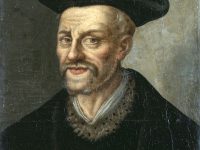Pieter Brueghel the Elder and the Dutch Golden Age of Painting
On September 9, 1569, Flemish painter Pieter Brueghel the Elder passed away. He was the most significant artist of Dutch and Flemish Renaissance painting, a painter and printmaker, known for his landscapes and peasant scenes. He is sometimes referred to as “Peasant Bruegel“, to distinguish him from the many later painters in his family, including his son Pieter Brueghel the Younger (1564–1638).[1] Pieter Brueghel the Elder – Background Little is known with…
Read more











